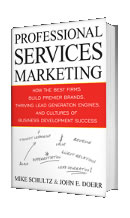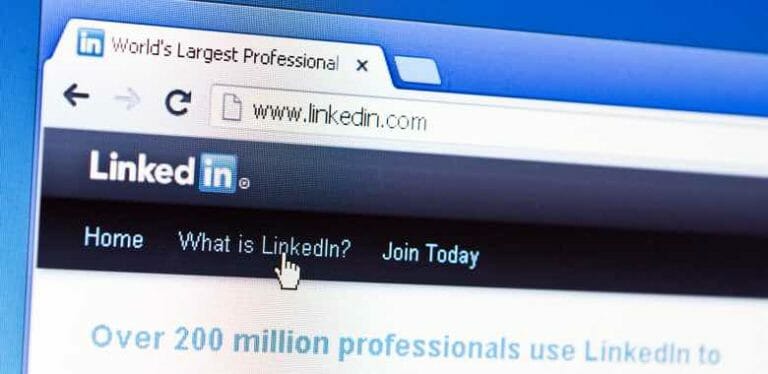Featured
Posted by Ian Brodie on August 1st, 2009.
Ian Brodie on August 1st, 2009.

Linkedin Tips For Building Your Professional Presence And Getting More Clients
My latest tips on building a
Client Winning Profile for Linkedin are now on a free, short video –
click here to watch it.
Linkedin is the “social network for business” and now has over 200 million users.
And many Linkedin users, myself included, have found new clients through it, and enhanced relationships with existing clients. But many others have found it to suck up a ton of time for very little gain. So here are 10 quick tips for getting the most from Linkedin.
1. Make your profile client focused
The first thing you do when you join Linkedin is to create a profile. And since Linkedin has slots for your previous job roles, qualifications, etc. there’s an almost overwhelming temptation to make your profile look like your CV.
Resist that temptation.
When you first meet potential clients you don’t rattle off a huge list of companies you’ve worked for and the responsibilities you’ve had – that would bore the pants off them. So don't do the same on Linkedin.
Most effective introductions focus on who you help, and what problems you help them solve or results you help them achieve. Then if asked more, you say a bit more about what you do – perhaps giving a little backstory as to why you are uniquely qualified to help, or an example of the work you do.
Linkedin is for making connections – and for the majority of professionals that means clients and business partners, not recruiters.
You need to design your profile to have the impact you want on those connections. Treat it like your introduction at a networking meeting.
Think about the impression you want to make on your potential clients. What will get them interested enough to read your profile? Probably something telling them you work with people just like them and deal with the sort of challenges they have.
What will make them read on? Probably some interesting examples that spell out and “prove” the results they could get by working with you.
What would make them contact you? Well, at minimum a call to action with details of how – a website, phone number or email address.
Whatever you do, don't just stick your CV details in there.
2. Get connecting – but…
Linkedin works on connections. The most powerful use of Linkedin is to find new clients and business partners through the search function or directly via your contacts' connections. The more direct connections you have, the more opportunities you have to connect. I still see people who’ve made all the effort to set up their Linkedin profile – but who have so few connections that they don’t get any benefit.
The Linkedin toolbar for Outlook provides an easy way of inviting the your Outlook contacts and people you email regularly to connect with you.
However, there’s a catch…
3…Choose your connection strategy carefully
There are two very different strategies to connecting on Linkedin: “Open Networking” and “Trusted Partner Networking”.
In business networking generally, the value you get from your network is a product of the size of your network, and your ability to “convert” connections into productive business (work, a referral, etc.). You can grow the value of your network by getting more connections, or deepening the strength of each connection (getting to know people better, helping them out, etc.)
On Linkedin, one strategy for getting value is to be an “Open Networker” or LION (LinkedIn Open Networker). Open Networkers focus on growing the size of their network by initiating and accepting connection requests from as many people as possible. Open Networkers typically have many thousands of connections. This means that when they search for useful relationships (potential clients or business partners), for example looking for contacts in specific companies, or geographies or with specific interests or job titles – they are much more likely to find them (exponentially more likely because of the way Linkedin connections work).
The downside of this strategy is that with thousands of connections they don’t know many of them particularly well, if at all. They’re essentially using Linkedin as a giant Rolodex or telephone directory rather than as a way of making deeper connections. That’s neither good nor bad – it just means that if they find someone they want to connect with through one of these “shallow” connections, they’re unlikely to get a strong referral to them – they'll still have to initiate a relatively cold contact.
The other strategy is to have fewer but deeper connections – a “Trusted Partner” strategy. Here you only connect to people you already know and trust. Most likely from face-to-face interaction, but possibly from online interaction too.
With this strategy you have less chance of finding someone via a search because you have less connections. But if you do find someone, it'll be through someone who knows and trusts you – and they'll be able to give a strong referral to you and put you in touch with the person you’re interested in connecting with.
The downside to the “Trusted Partner” strategy is that it’s a bit like going to a face to face networking event and only speaking to the people you already know. You deepen your relationship with them – but you don’t build any new relationships.
Personally, I take a “middle way” and I recommend you do the same.
I don’t actively go out and connect with huge numbers of people. But if someone wants to connect with me, and their profile looks interesting – then I’m very happy to connect with them, even if I don’t know them. If they do turn out to be a “spammer” (I’ve only had this happen once with over 1,000 connections) then I can always disconnect.
This way, my network expands significantly. I meet new people who may turn out to be helpful to me, and I may be helpful to them.
I always try to take the time when people connect with me to send them a message to start a conversation rather than just accept the connection but never speak to them. That way we find out more about each other and it may lead to interesting and valuable discussions. At minimum, it means that if I want to ask a favour later, we'll actually have interacted before.
4. Use Search to find potential clients and business partners
This is perhaps the most important of my Linkedin Tips.
Many people get going on Linkedin but fail to use it to help their business. Absolutely the most effective way I've found to gain business value from Linkedin is to find potential clients and business partners. One of the things I do in my consulting practice is to help clients get more referrals for their business. And one of the key things I teach them is to be very specific in who they ask to be referred to.
Linkedin allows the ultimate in specificity. You can search for exactly who you want to be referred to – by company, by geography, by name, by job title, etc. And you can search across your entire network at once. Or you can look at the contact list of an individual to see if there’s anyone you’d like to be connected to.
Almost everyone I've taught to do this has been staggered by just how many people their contacts know that they'd love an introduction to. Yet before using Linkedin they had no idea that they were connected.
Once you’ve identified people you’d like to be introduced or referred to, rather than try to connect them directly, give your mutual connection a call and ask them if they can connect you. That’s much more polite than going directly, and it’s much more likely to be successful.
5. Give recommendations and endorsements to get them
Recommendations are very helpful to have on your profile. They’re a clear indication of the quality of your work and the relationships you form.
But begging for a recommendation isn’t a great strategy.
If you want to get recommendations, use Linkedin to give them to people you’ve worked with and who have done a great job for you. Linkedin will show them the recommendation to approve, then ask them if they want to reciprocate. They probably will.
Similarly with the new Endorsement feature, if you endorse someone, they'll be notified and you're likely to get a reciprocal endorsement in return. if you get an impressive number of endorsements you can move them up in your profile to just under your summary. So the first thing people see after finding about about you is that lots of people think you're great.
6. Have a helpful Professional Headline
Another one of my most impactful Linkedin Tips. When people find you in searches on Linkedin, the initial thing they see is a little box with your name, photo, and your “professional headline”.What most people have in their headline is their job title. “Owner at XYZ Company” or “Principal consultant at ABC Ltd”. By default, unless you change it manually, Linkedin takes the headline from your last job title.
Unfortunately, this doesn’t give people a clue as to whether you might be able to help them, or might be interesting to connect to.
You should treat your headline like your introduction when networking. Focus on what you can do to help people.
My headline, for example is “Straight talking advice for Consultants and Coaches to help them Attract Clients and Win More Business”. It’s much more useful in telling people what I actually do than using an “official” job title like Managing Director. That will get more people to click through to my profile and maybe begin to interact with me.
You can edit your Headline via the Edit My Profile option.
7. Join Linkedin Groups to connect and interact (but be careful)
Linkedin groups are essentially discussion forums for specific interest groups. They allow you to find out the latest news, and to join in debates on topics of interest. You can join groups both of interest to you professionally, and the groups where your potential clients “hang out”.
Some people have reported great success in meeting potential clients and building their credibility by being helpful and answering questions on Linkedin Groups. But be careful. My own experience is that far more people end up wasting hours of time in fairly idle chatter, or in trying to sound clever but with very little impact.
Before you join a group, click on the link to check out the group statistics and look at the activity stats. What you want to see is a lot more comments than discussions started every week. Lots of comments means members are actively engaging with each other. Lots of discussions with few comments means people are just posting their stuff and no one is reading or engaging with it.
8. Use Status Updates to subtly remind your contacts of what you do
Linkedin status updates are a nice way of helping to stay top of mind with contacts. If you were to call or email all your contacts any time you did something small but interesting, it would quickly become seen as pushy or spammy. But updating your status is an non-intrusive way of getting a gentle reminder out.
Depending on their settings, your contacts will get a regular email with a summary of the status updates of their contacts. And they will see the updates on their Linkedin homepage. Mostly it will just be “so and so updated their profile” type messages. So if your status update has something interesting in it (“Ian has just run a seminar on consultative selling skills”) it will remind them of the sort of thing you do and may even trigger them into action.
Recently, for example, I put up a status update saying I’d run a training course on Marketing for Consultants for the Institute of Business Consulting. That prompted one of my old colleagues to get back in touch and we came to an arrangement about sharing training material.
You can also share your latest blog post and other useful resources. Be careful through: Linkedin isn't Twitter and your connections won't appreciate you making dozens of updates a day as it will mean they can't won't anything from their other contacts.
9. Watch others’ status updates to initiate contact
Keep an eye on status updates from others – it can be a good opportunity to get back in touch – especially if they’ve changed jobs or have set out on a new venture. Even small status changes can help give you something to start a conversation – the sort of smalltalk needed to keep dialogues and relationships going in between more meaty topics.
These days many CRM systems like Salesforce and Highrise offer “Social CRM” features. They make it easy to find your contacts on Linkedin (and Facebook and Twitter) and track their activity on their profile page on the CRM.
10. Keep your use of Linkedin in balance
This is less a tip about using Linkedin, and more a tip about not using Linkedin.
Do bear in mind that Linkedin is just a tool. And it's one that's very easy to spend too much time on. Endlessly tweaking your profile to make it just that little bit more perfect isn't going to bring you any new business. Nor is chatting away on a discussion group to buddies you already know.
Be judicious in your use of Linkedin. Get a good profile. Make sure you're connected to people you know would recommend you, then harness that network to get introductions to potential clients. In a couple of upcoming articles I'll show you who to do that in the most effective way.
But make sure you're not sucked in to spending hours a week playing around with it.
More Linkedin Tips:
How To Optimize The New Linkedin Profile >>
The Number One Linkedin Mistake And How To Fix it (Free Video) >>
The Real Secrets of Linkedin >>
 One question I get asked quite often is “Can you recommend a good book on marketing professional services?”.
One question I get asked quite often is “Can you recommend a good book on marketing professional services?”.
 Let's face it: professionals hate selling.
Let's face it: professionals hate selling. How many meetings with clients have you been to that were aimless, unstructured and poorly planned?
How many meetings with clients have you been to that were aimless, unstructured and poorly planned?
 A common problem many professional firms face is overly relying on only one approach to business development. They focus all their efforts on word-of-mouth & referrals, or on networking, or on responding to tenders/RFPs. Typically, the basket they keep all their eggs in is the one they are the most comfortable with: it's worked for them before, they have the skills to do it, and it doesn't push them outside their comfort zone.
A common problem many professional firms face is overly relying on only one approach to business development. They focus all their efforts on word-of-mouth & referrals, or on networking, or on responding to tenders/RFPs. Typically, the basket they keep all their eggs in is the one they are the most comfortable with: it's worked for them before, they have the skills to do it, and it doesn't push them outside their comfort zone. One of the biggest challenges I find clients have when trying to get more referrals is that their referrers (the people they've asked to introduce them to someone) struggle to make the introduction sound attractive to the potential client.
One of the biggest challenges I find clients have when trying to get more referrals is that their referrers (the people they've asked to introduce them to someone) struggle to make the introduction sound attractive to the potential client. This is the second in a series of posts on how Professional Firms can get more referrals. Read the first in the series –
This is the second in a series of posts on how Professional Firms can get more referrals. Read the first in the series – 